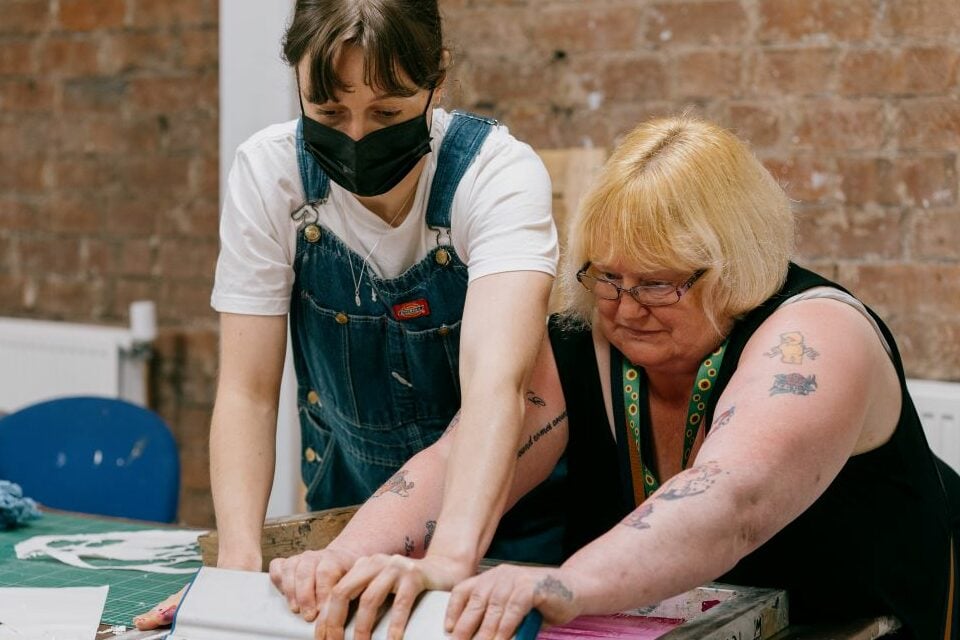
Mafwa Theatre print workshop
Photo: Tom Arber
Reimagining cultural data
Reflecting on the new book Pandemic Culture, Stephen Dobson, director of the Centre for Cultural Value, argues we now need smarter, more people- and place-centred data to inform cultural policymaking.
Last month marked the official launch of Pandemic Culture, based on research led by the Centre for Cultural Value (the Centre). The book offers an impressive body of research from 35 collaborators, capturing the impacts of the pandemic on the cultural sector as it was happening.
Genuinely cross-disciplinary, its production has, in many respects, forged a fundamentally different way for academics and researchers to work with policymakers.
Making a positive difference in real time
The discussions at the book’s launch focused on key areas. Firstly, that impacts of the pandemic are still being felt. As data from The Audience Agency show, people remain reluctant to return to live arts and cultural activities.
And secondly, there is a need for a fairer and more equitable sector alongside acknowledgement of the critical role and importance of networks in the early stage of the pandemic in helping organisations survive.
Four years on, we still feel the effects. But the publication research has opened up new ways of working and revealed the immense value in harnessing data about the arts and cultural workforce. It’s also introduced a new awareness of audience behaviours, especially as organisations pivoted to digital provision, albeit with mixed success.
Pandemic Culture has revealed new insights, laid bare old and previously under-acknowledged disparities in the sector, and provided a glimpse into the future – one in which research and policymaking could be more closely connected and agile, and where we can make a positive difference in real time.
It’s clear we work differently now. Arts and culture have always adopted a civic role but there’s perhaps an increased need for utility too, and a greater civic responsibility.
The summer of 2024 was an extremely challenging one in the UK with far-right, anti-immigration protests and riots. The need to harness culture as a means to connect, build cohesion and heal fractured places is keenly felt by many in the sector.
Regenerative culture
This is the moment to relearn the lessons we gained from the pandemic and ensure the collective sense of purpose is reignited. But if this is a moment to reflect and reset, then it should also lead to a kinder, more ethical and supportive sector for all those who work in it, especially freelancers who represent those with the greatest precarity.
Across the whole business landscape, freelancers make up 15% of the workforce. For the creative industries this rises to 32%. However, the proportion of freelancers is much greater in visual arts (70%) and theatre (70%), and highest amongst musicians (80%).
Policymakers didn’t fully understand the impact of the pandemic on these freelancers. So in 2021, the Centre, in partnership with the Creative Industries Policy and Evidence Centre and The Audience Agency, led research into the issue.
Organisations benefit greatly from an innovative and agile freelance workforce. So it’s important to consider how the whole ecosystem of funders, organisations and cultural institutions can come together and provide sufficient support to these crucial members of the sector. And all without forming gaps for so many to fall through at times of crisis.
More data, new ways of working
In Ben Walmsley’s article What would a regenerative cultural sector look like?, he calls for such a resilient ecosystem to help us navigate the most challenging times.
It’s here where we need to make data work for us: to support agile decision-making, and target support, skills development and understanding to make the best use of limited resources. We need to share evaluation insights, and indeed our learning from failure, to facilitate a stronger sector all round.
Audience insight can help organisations pivot to more appropriate business models, to innovate and build a depth of understanding about community needs. But it’s also important our data strategies are aligned to the goals of an arts and cultural sector.
This isn’t about the never-ending pursuit of operational efficiency. Walmsley reinforces that it involves “making the often-difficult decision to do less – but doing it in smarter, more sustainable ways”.
This is a clear message to rethink the traditional business mantra and harness data about the sector in ways that support and enrich its offering, alongside achieving this through more collaborative and collective means than perhaps has characterised other sectors.
Collaborative ecosystems
Interestingly, this need to rethink the old ways of fostering a competitive environment is gaining traction. In 2023, the World Economic Forum published Competition vs collaboration: rethinking how businesses innovate and grow. In the report, high churn rates and the pressures on businesses to keep delivering and producing more and more value are cited as unsustainable:
“Competition has long been the default mode for companies across industries — indeed, an element of competition will always be necessary to drive growth. But the time has come to recognise that collaborative models may outperform purely competitive ones.”
Competitive logic is in question here, in favour of stronger ecosystems of collaboration. Pandemic Culture is a timely reminder that this is where our sector excels, and that collaboration is the platform for regeneration and strength.
This is why our data needs should be grounded in delivering a sustainable, equitable, enriching and exciting cultural offer rather than simply being harnessed to gain competitive advantage.
Download a free copy of Pandemic Culture here.
Join the Discussion
You must be logged in to post a comment.